# BugIt插件
BugIt 是一个Issue提交的插件,目前应用于提交Bug场景下。
配合其他插件,BugIt提供了一种准确、快捷、有效的Issue生成服务。除填写Issue配置字段外,BugIt还提供Lyrebird中自定义脚本与其他自定义插件(Android、iOS)数据。
通过脚本配置,可支持任意Bug管理系统。
# 快速开始
# 环境要求
macOS OR Linux
Python3.6及以上
Lyrebird 1.6及以上
# 安装
pip3 install lyrebird-bugit
# 载入脚本文件
BugIt workplace 配置由Lyrebird配置文件统一管理。
通过修改 ~/.lyrebird/conf.json 中 "bugit.workspace" 的值,可以修改 BugIt 读取脚本文件的路径。
对脚本的新增、修改、删除,可以在该目录下操作文件。
TIP
使用BugIt时,必须有一个及以上的脚本文件
配置脚本请参考示例脚本。
# 功能介绍
# Bug提交
读取脚本文件后,BugIt会得到一个Bug信息填充的界面,称之为Bug表单。
用户可以自定义Bug字段的 名称、先后顺序、填写样式、默认值。
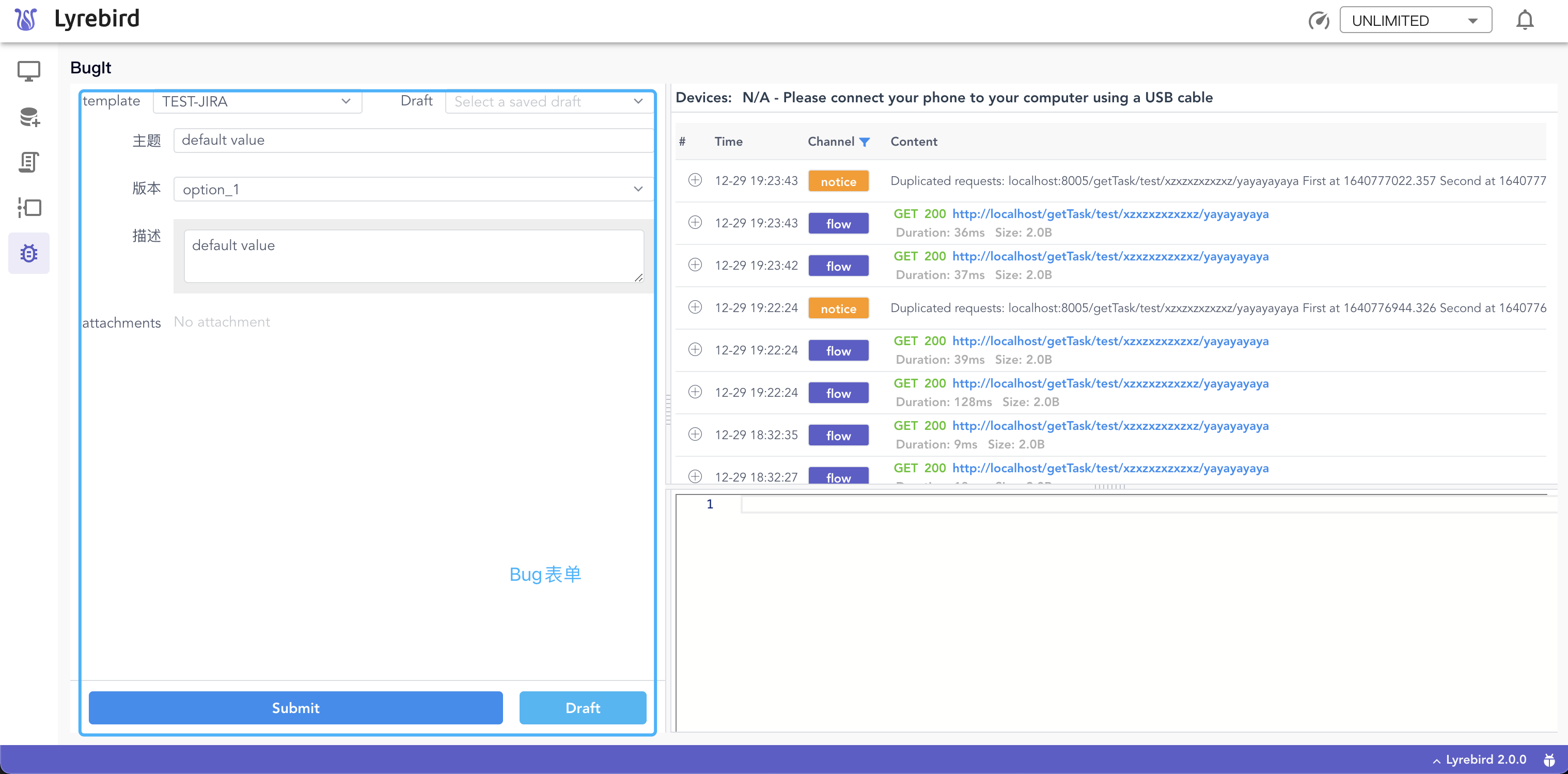
BugIt可以通过配置服务向任意Bug管理系统提交Issue
# API数据获取
BugIt支持自动填充Lyrebird运行过程中抓取到的数据信息。
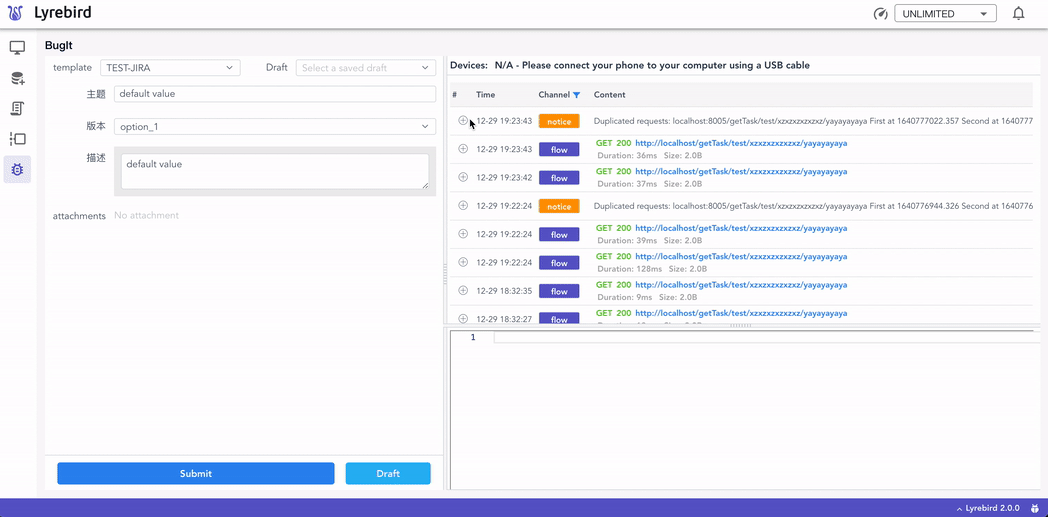
# 报警获取
在自定义脚本捕获报警后,可以通过通知中心随时跳转至BugIt。
在右侧数据面板中,可以对历史消息总线中的信息进行回溯,补充至Bug中。
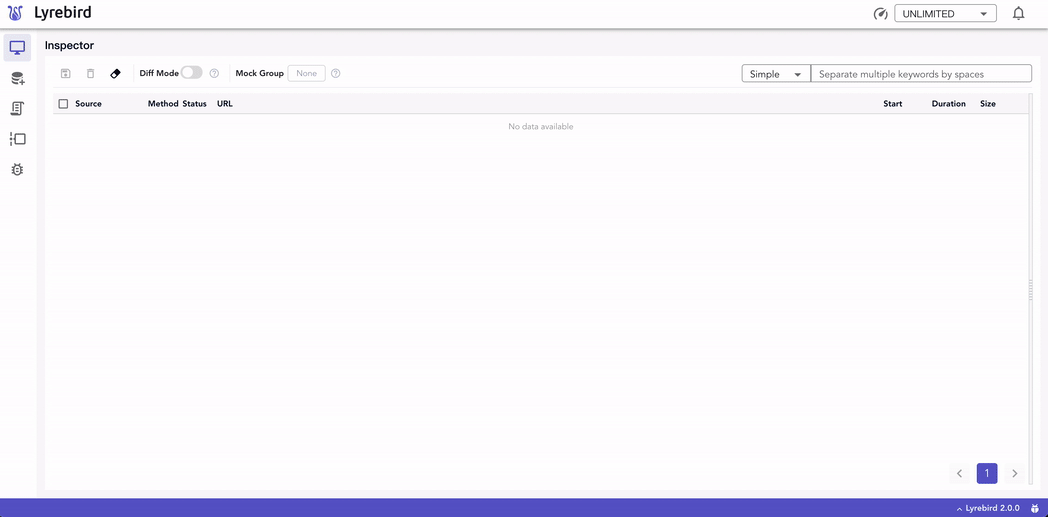
# 保存草稿功能
按下[Commond]+[s]键,会将Bug相关字段信息进行存储为默认草稿Default。
自定义草稿步骤如下:
- 点击Draft按钮
- 在弹出框中编辑草稿名称(默认为Default),草稿名称不能重复。
- 点击保存会将Bug相关字段信息进行存储为该模板下的一份草稿。
草稿信息不受Lyrebird服务开关、浏览器缓存、脚本/界面切换的影响。
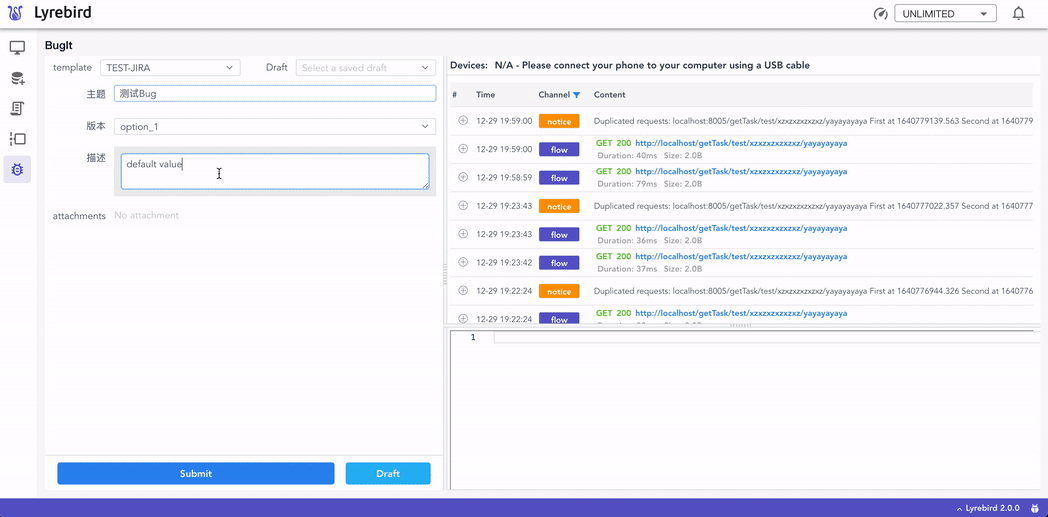
有效的利用缓存功能,是提高Bug上报效率的关键。
# 插件在Bugit中的应用
# Android iOS插件
安装Android插件、iOS插件后,BugIt支持设备信息扩展服务。
- 设备信息获取
- BugIt 支持将设备名称、设备系统版本、被测 App 信息(Bundle ID(iOS)/PackageName(Android))填充到Issue内容中。
- 实时设备截图
- BugIt 可以实时获取设备截图,并支持在截图上进行涂鸦、文本标记。
- 提交 Bug 时,截图将作为附件一并提交给脚本配置服务。
- Crash Log 获取
- 在Lyrebird运行过程中,如发生 被测 App 发生 Crash,BugIt 会捕获到 Crash Log。
- 提交 Bug 时,Crash Log 将作为附件一并提交给脚本配置服务。
- Crash 获取 暂不支持 iOS 设备
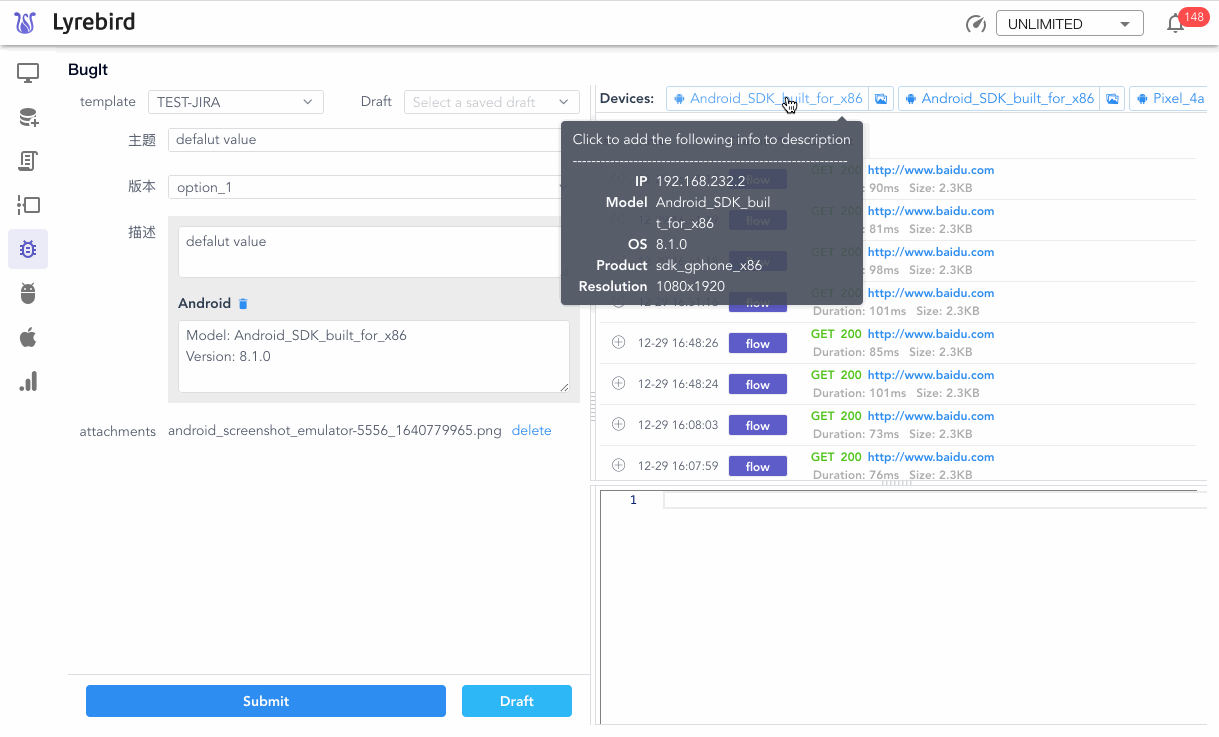
# Bug脚本说明
BugIt通过加载配置脚本提供向Bug管理系统提交Issue的功能
# 脚本示意图
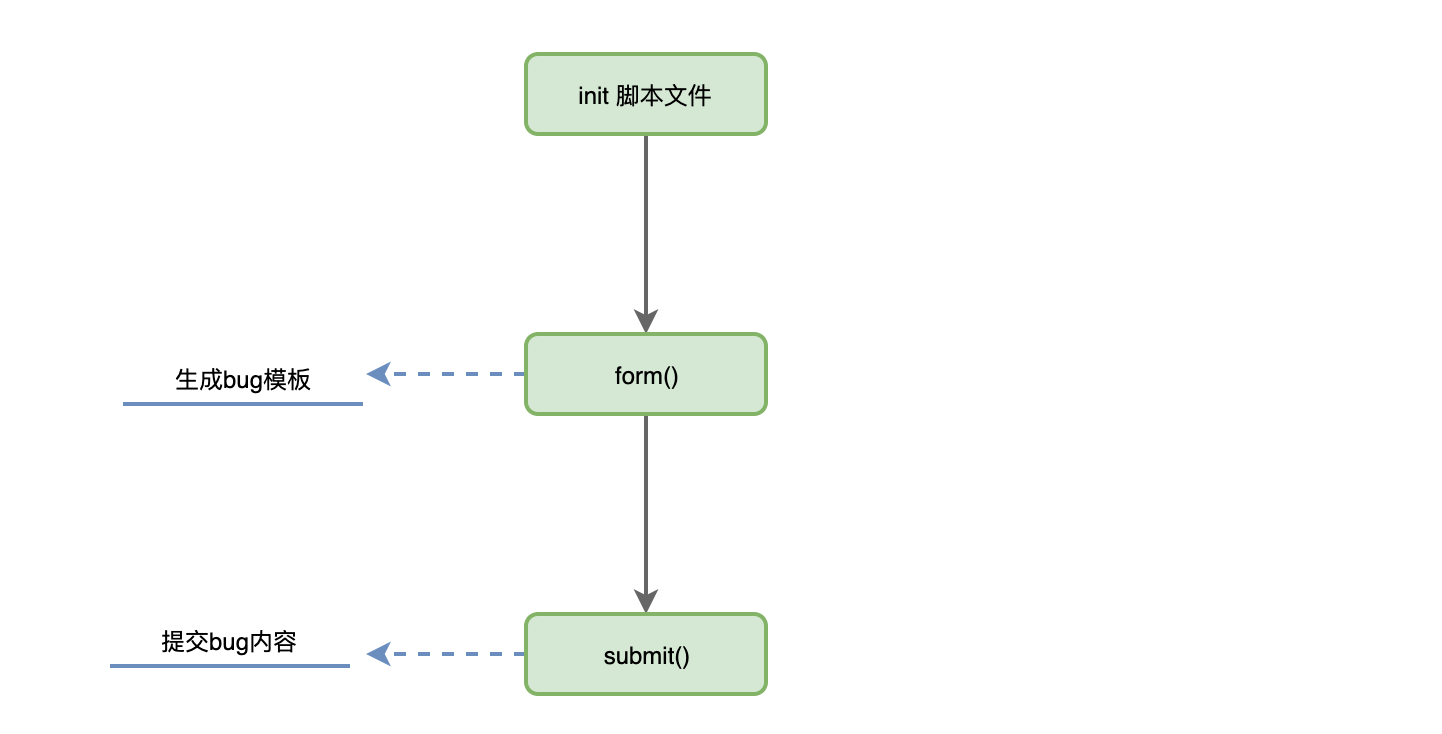
配置脚本需包含以下三部分
# BugIt数据传递
context 用于存储 BugIt 运行过程中产生的数据信息。form()、submit()方法依赖于这些数据信息实现Bug信息的展示与提交
context关键字说明
| key | 说明 | 使用场景 |
|---|---|---|
| cache | 存储Bug缓存信息,详细用法请参考Bug信息缓存 | form() |
| issue | 存储Bug表单信息 | issue() |
| key | 存储最近一次提交成功的Issue key | issue()、attachments() |
| attachments | 存储需要上报的附件信息 | attachments() |
# init配置文件
BugIt 通过 name 来标识配置文件。
TIP
BugIt 脚本必须含有 'name' 属性
"""
Template name
"""
name = 'TEST-JIRA'
name 用于在 BugIt 前端页面上展示脚本名称。
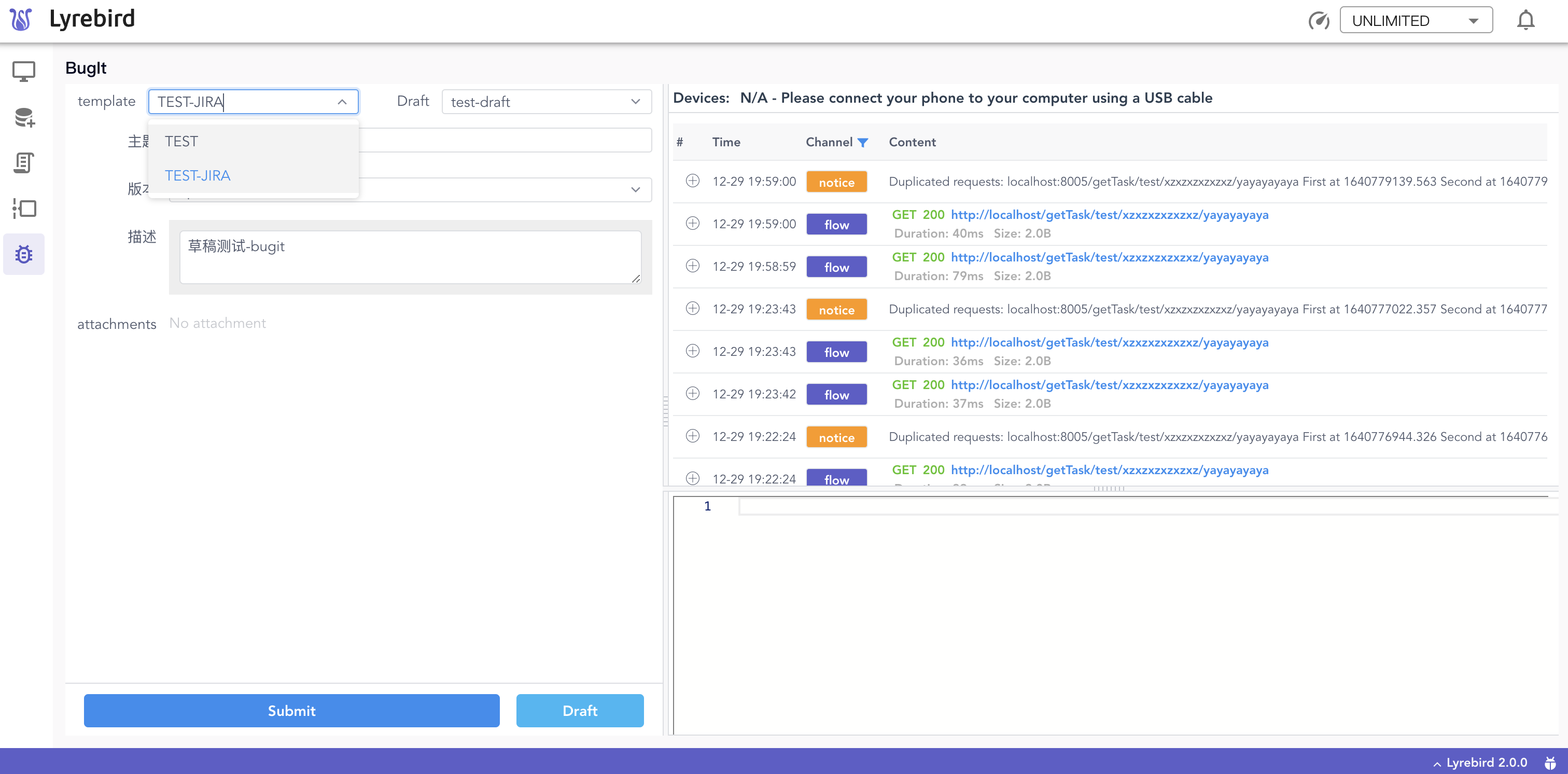
选中配置文件后,BugIt init 脚本文件,获取脚本文件中回调方法(form()、submit())。
# form()
form() 方法用于自定义Bug表单的字段与填写样式。
Bug 中的每一字段由一dict定义(通常称之为FormItem),表单配置时,通过dict的以下关键字去控制字段的名称、默认值、样式等内容。
TIP
form()方法应返回一由FormItem组成的list。
# FormItem dict说明
| key | 说明 | 枚举值 | 是否必填 |
|---|---|---|---|
| name | 展示在页面上的字段名称 | -- | Y |
| value | 对应字段填充的值 | -- | N |
| component | 字段展示的组件形式 | 'input'、'select'、'compoundTextarea' | Y |
| options | 配合 select component使用,用于存放select component的选项内容 | -- | N |
# BugIt 支持的 component
- input
form_item_input = {
'name': '主题',
'component': 'input',
'value': 'defalut value'
}
input 组件会生成一个文本输入框,在声明时如果 value 不为空,则会作为默认值填充在输入框中
- select
form_item_select = {
'name': '版本',
'component': 'select',
'options':[
{'id':'001','name':'option_1'},
{'id':'002','name':'option_2'}
],
'value': '001'
}
select组件会生成一个筛选框,筛选项由 options 定义,options 为一个 list,其中每一元素为 dict 类型。
option dict说明
| key | 说明 | 是否必填 |
|---|---|---|
| id | 筛选项唯一标识 | Y |
| name | 筛选项在前端展示文本内容 | Y |
TIP
select 组件中,value应为option dict中对应 id 的值
- compoundTextarea
compoundTextarea组件会生成一个文本框,在声明时如果 value 不为空,则会作为默认值填充在文本框中
form_item_text = {
'name': '描述',
'component': 'compoundTextarea',
'value': 'defalut value'
}

compoundTextarea组件在 BugIt 中还用于支持 Lyrebird 其他信息的扩展。
选择消息总线或其他插件的数据时,该数据将作为附加信息展示在 compoundTextarea 中。
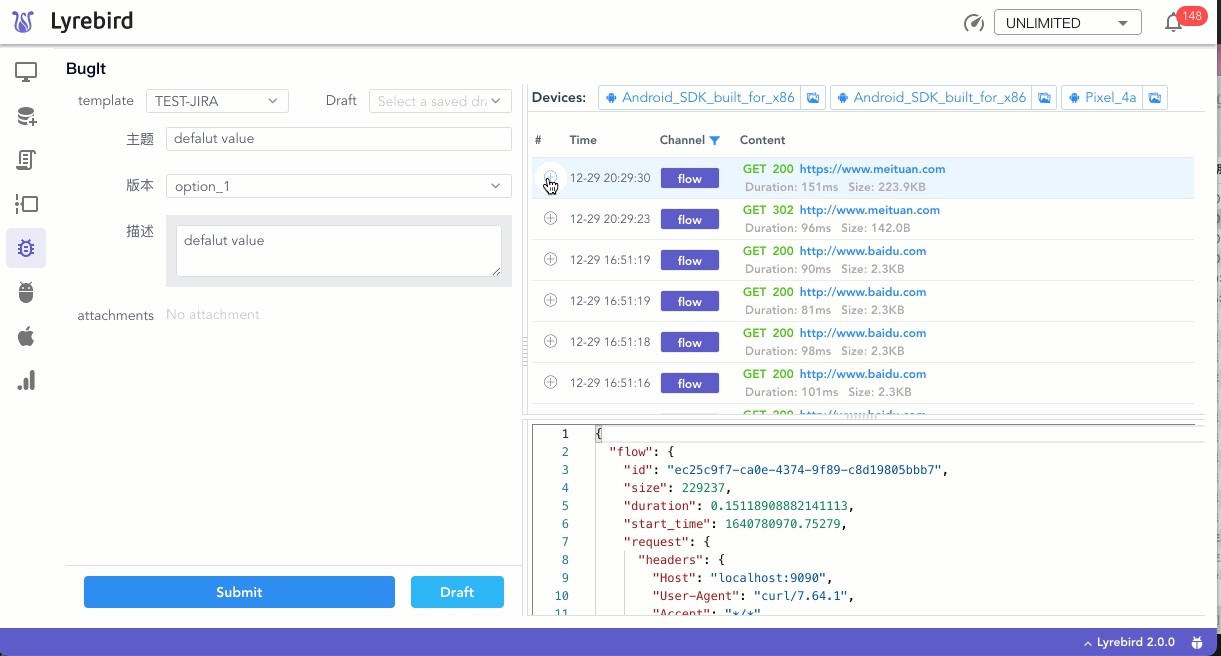
对应的数据信息将作为 'extraMsg' 存放在 FormItem中。 此时From Item变成
form_item_text = {
'name': '描述',
'component': 'compoundTextarea',
'value': 'defalut value',
'extraMsg':[
{'message':'Flow Info'},
{'message':'Notice Info'},
{'message':'Devices Info'}
]
}
# form()方法示例代码
def form(context):
"""
BugIt callback function
BugIt will call this function when user select this template from UI.
This function should return a array, list all FormItem dict.
"""
form_item_input = {
'name': '主题',
'component': 'input',
'value': 'defalut value'
}
form_item_select = {
'name': '版本',
'component': 'select',
'options':[
{'id':'001','name':'option_1'},
{'id':'002','name':'option_2'}
],
'value': '001'
}
form_item_text = {
'name': '描述',
'component': 'compoundTextarea',
'value': 'defalut value'
}
form = [form_item_input,form_item_select,form_item_text]
return form
示例代码生成的 Bug 表单如下图所示
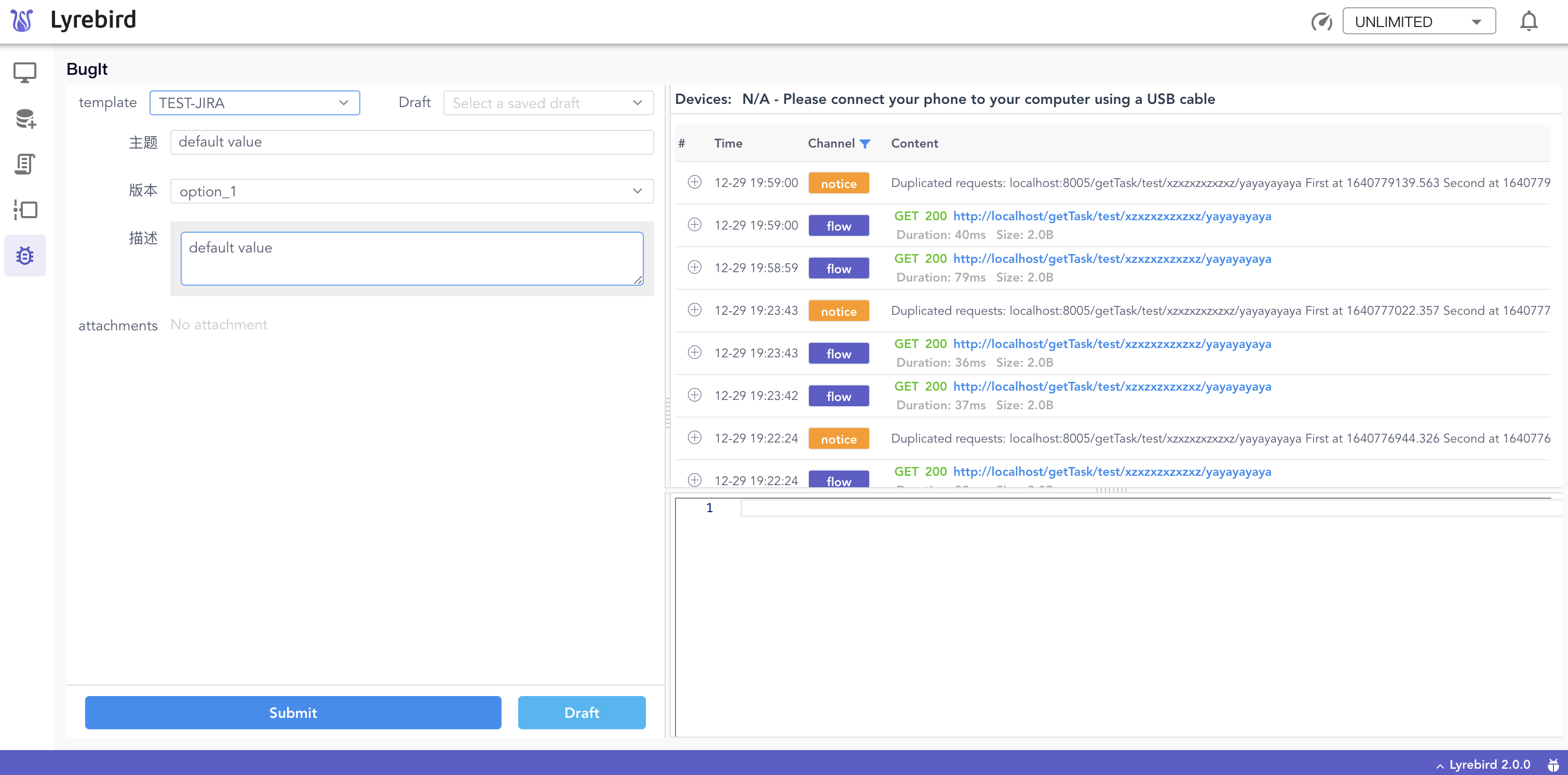
# submit()
submit()方法用于向bug系统上提交Issue,生成Bug。
TIP
submit()方法返回一组用于处理 submit 行为的方法。
方法说明
| 方法名 | 入参 | 说明 |
|---|---|---|
| issue | context | 处理 Bug表单中的信息,通过 API 向 Bug 管理系统提交 Issue |
| attachments | context | 处理附件信息(如 Android插件、iOS插件提供的截图或 Log),通过 API 向 创建的 Issue 中添加附件 |
# submit()方法示例代码(以JIRA服务为例)
def submit():
"""
BugIt callback function
BugIt will call this function when user tap submit button.
This function should return a array, contains all submit actions.
Each submit-action function have a argument. It contains form data and attachments info.
"""
return [issue, attachments]
def issue(context):
"""
This function is used to submit Issue
"""
form_data = context['issue']
jira_fields = {}
# transform from_data to payload submited to API of JIRA
for form_item in form_data:
if form_item['name'] == '主题' :
jira_fields['summary'] = form_item['value']
elif form_item['name'] == '版本':
jira_fields['version'] = {
id:form_item['value']
}
elif form_item['name'] == '描述':
jira_fields['description'] = form_item['value']
# add extraMsg to description
if form_item['extraMsg']:
for add_des in form_item['extraMsg']:
jira_fields['description'] +='\n'
jira_fields['description'] +='------------------------------\n'
jira_fields['description'] +=add_des['message']
url = 'http://www.example.com/jira/rest/api/2/issue'
header = {
'Content-Type': 'application/json;charset=utf-8'
}
resp = requests.post(url, auth=('YOUR JIRA_USER_NAME', 'YOUR_JIRA_PASSWD'),json={"fields": jira_fields},headers=header)
if resp.status_code >= 200 and resp.status_code < 300:
body = json.loads(response.text)
if body.get('key') :
context['key'] = body['key']
else:
raise Exception(f'Submit failed {response.text}')
else:
raise Exception(f'Create issue failed with code {response.status_code}\n{response.text}')
def attachments(context):
"""
This function is used to upload attachments to the Issue which has been created
"""
key = context['key']
attachments = context['attachments']
if len(attachments) == 0:
# No attachments
return
url = f'http://www.example.com/jira/rest/api/2/issue/{key}/attachments'
headers = {
'X-Atlassian-Token': 'nocheck'
}
multiple_files = []
# transform attachment data to payload submited to API of JIRA
for attachment in attachments:
attachment_path = Path(attachment['path'])
multiple_files.append(
('file', (attachment_path.name, open(str(attachment_path), 'rb')))
)
response = requests.post(url, files=multiple_files, headers=headers)
if response.status_code == 200 and response.json()['code'] == 0:
print('Submit attachments success')
else:
raise Exception(f'Submit failed {response.text}')
# 脚本高级
# Bug表单动态化配置
在提交Bug场景中,Bug表单的配置可能会由于项目结构的调整而发生变化。配置脚本的频繁变更会带来额外的工作量及不稳定因素。
针对此问题,可以采用动态化配置Bug表单的方法使 BugIt 更加灵活。
以以JIRA (opens new window)服务为例,我们可以通过 API 实时地获取到 Bug 表单所需要的字段及格式。在 form() 方法中对API返回表单数据进行组装,返回符合 form() 预期结果的 list
# 示例代码
PROJECT_KEY = 'TEST'
ISSUE_TYPE_ID = '10'
def get_fields_metadata_from_JIRA_API():
"""
Get origin fields by JIRA Rest API
projecKeys: Set your project key
issueTypeId: Set your issue type id
expand: projects.issuetypes.fields
"""
response = requests.get(
f'http://http://www.example.com/jira/rest/api/2/issue/createmeta?projectKeys={PROJECT_KEY}&issuetypeIds={ISSUE_TYPE_ID}&expand=projects.issuetypes.fields')
result = response.json()
fields = result['projects'][0]['issuetypes'][0]['fields']
return fields
def make_options(field):
"""
Make options of FormItem when field is select component
"""
for option in field['allowedValues']:
if 'name' not in option:
option['name'] = option['value']
return field['allowedValues']
def make_item(key, field, value=None, component=None):
"""
Make origin field from JIRA to FieldItem
key: JIRA field key
name: Displayed as the FormItem name
schema: JIRA field schema
"""
schema = field['schema']
item = dict(key=key, name=field['name'], required=field['required'], schema=schema)
if value:
item['value'] = value
if 'allowedValues' in field:
item['component'] = 'select'
item['options'] = make_options(field)
else:
item['component'] = 'input'
if component:
item['component'] = component
return item
def form(context):
jira_fields = get_fields_metadata_from_JIRA_API()
custom_fields = OrderedDict({
'描述': {
'component': 'compoundTextarea'
}
})
required_fields = []
for field_key in origin_fields:
field = origin_fields[field_key]
if field['name'] in custom_fields:
custom_fields[field['name']].update(make_item(
field_key,
field,
component=custom_fields[field['name']].get('component')
))
elif field['required']:
required_fields.append(make_item(field_key, field))
else:
pass
form = [*list(custom_fields.values()), *required_fields]
return form
# Bug信息缓存
在form()方法中,利用context可以实现数据缓存功能
# 示例代码
def form(context):
form = []
# Your code to make form
"""
get cache if it exsit
field value will be filled with cache value
"""
if context.get('cache'):
for field in form:
for cache_field in context.get('cache'):
if cache_field['key'] == field['key']:
field['value'] = cache_field.get('value','')
return form
# 示例脚本
此示例脚本以JIRA (opens new window)服务为例
"""
Template name
"""
name = 'TEST-JIRA'
def form(context):
"""
BugIt callback function
BugIt will call this function when user select this template from UI.
This function should return a array, list all FormItem dict.
"""
form_item_input = {
'name': '主题',
'component': 'input',
'value': 'defalut value'
}
form_item_select = {
'name': '版本',
'component': 'select',
'options':[
{'id':'001','name':'option_1'},
{'id':'002','name':'option_2'}
],
'value': '001'
}
form_item_text = {
'name': '描述',
'component': 'compoundTextarea',
'value': 'defalut value'
}
form = [form_item_input,form_item_select,form_item_text]
"""
get cache if it exsit
field value will be filled with cache value
"""
if context.get('cache'):
for field in form:
for cache_field in context.get('cache'):
if cache_field['key'] == field['key']:
field['value'] = cache_field.get('value','')
return form
def submit():
"""
BugIt callback function
BugIt will call this function when user tap submit button.
This function should return a array, contains all submit actions.
Each submit-action function have a argument. It contains form data and attachments info.
"""
return [issue, attachments]
def issue(context):
"""
This function is used to submit Issue
"""
form_data = context['issue']
jira_fields = {}
# transform from_data to payload submited to API of JIRA
for form_item in form_data:
if form_item['name'] == '主题' :
jira_fields['summary'] = form_item['value']
elif form_item['name'] == '版本':
jira_fields['version'] = {
id:form_item['value']
}
elif form_item['name'] == '描述':
jira_fields['description'] = form_item['value']
if form_item['extraMsg']:
for add_des in form_item['extraMsg']:
jira_fields['description'] +='\n'
jira_fields['description'] +='------------------------------\n'
jira_fields['description'] +=add_des['message']
url = 'http://www.example.com/jira/rest/api/2/issue'
header = {
'Content-Type': 'application/json;charset=utf-8'
}
resp = requests.post(url, auth=('YOUR JIRA_USER_NAME', 'YOUR_JIRA_PASSWD'),json={"fields": jira_fields},headers=header)
if resp.status_code >= 200 and resp.status_code < 300:
body = json.loads(response.text)
if body.get('key') :
context['key'] = body['key']
else:
raise Exception(f'Submit failed {response.text}')
else:
raise Exception(f'Create issue failed with code {response.status_code}\n{response.text}')
def attachments(context):
"""
This function is used to upload attachments to the Issue which has been created
"""
key = context['key']
attachments = context['attachments']
if len(attachments) == 0:
# No attachments
return
url = f'http://www.example.com/jira/rest/api/2/issue/{key}/attachments'
headers = {
'X-Atlassian-Token': 'nocheck'
}
multiple_files = []
# transform attachment data to payload submited to API of JIRA
for attachment in attachments:
attachment_path = Path(attachment['path'])
multiple_files.append(
('file', (attachment_path.name, open(str(attachment_path), 'rb')))
)
response = requests.post(url, files=multiple_files, headers=headers)
if response.status_code == 200 and response.json()['code'] == 0:
print('Submit attachments success')
else:
raise Exception(f'Submit failed {response.text}')
# JIRA API Reference
← API覆盖率插件